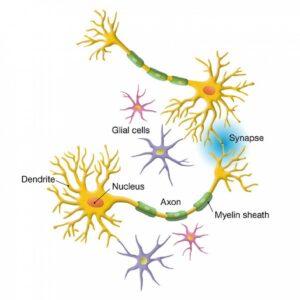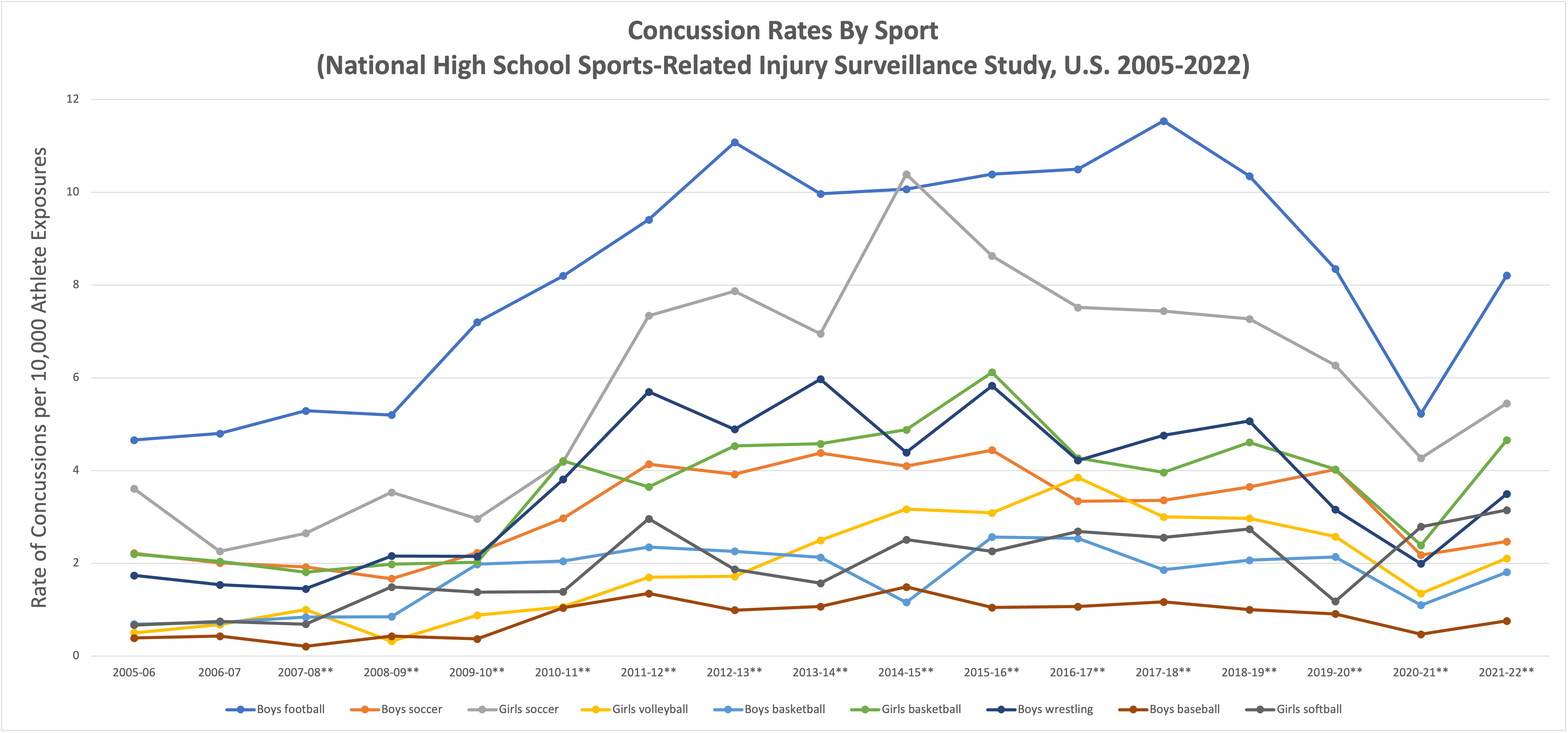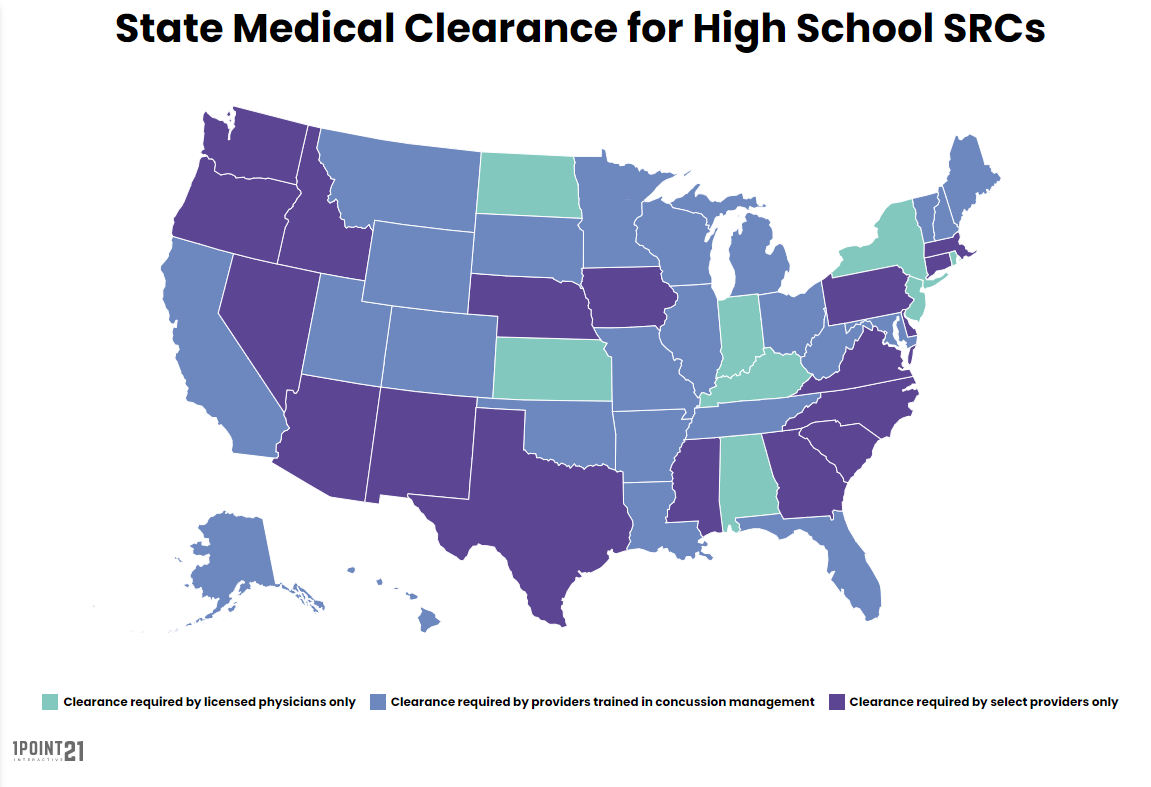Sports have long been a popular extracurricular activity for many high school students, providing opportunities for exercise, discipline, and team building. Over half of all high school students have participated in a sport since 1999, so its popularity can’t be denied.
With sports, however, comes sports-related concussions (SRCs). Concussion rates have become an increasingly prominent concern for parents, athletes, and coaches alike in recent years. In a similar vein to other sports professionals, high school athletes are susceptible to concussions due to the physical nature of many sports in both practice and competition.
Concussions occur as a result of any sudden force to the body that causes the brain to shake rapidly back and forth within the skull. This movement harms the brain’s neurons by causing them to stretch and sometimes break, leading to complications with brain function.
Concussions are classified as a minor traumatic brain injury (mTBI) because they cause cellular damage to the brain on a microscopic level. This is different from moderate to severe traumatic brain injuries, as these are marked by structural injury in addition to cell injury.

Neurons are the most important type of brain cell. Concussions cause neurons and axons to stretch and break, making them hard to communicate as a network.
As the brain’s neurons become injured from impact, stretched and broken axons leak chemicals. These highly compromised neurons ultimately lose the ability to communicate with other cells as a network, impacting normal brain function and leading to typical concussion symptoms like tiredness and mental fogginess.
Signs and symptoms of SRCs can be classified into 5 categories: somatic, vestibular, oculomotor, cognitive, emotional, and sleep. Headaches are the most frequently reported SRC symptom, followed by dizziness, loss of concentration, and confusion. Researchers have found that most somatic symptoms (symptoms related to the body) disappear within a few days.
Thankfully the odds of surviving a concussion are very high. 85-90% of athletes with a singular SRC fully recover within a month.
The risk of wrongful death from a sports-related concussion significantly increases when the concussed athlete returns to play too early and experiences a second head injury before the first one has completely recovered. This is known as second impact syndrome (SIS), and it is classified as a serious traumatic brain injury.
The fatality rate for SIS is high. The consecutive blow to the head further harms the brain and causes it to swell inside the skull, quickly leading to reduced blood flow and brain herniation. There are accounts of football players returning to play too early and dying less than 5 minutes after a second head injury.
The National High School Sports-Related Injury Surveillance Study has assessed 9 sports and their concussion occurrences.

Football is the high school sport that has the most concussions. Per 10,000 athletic exposures, high school football players will have an average of 11.2 concussions. This is a higher rate than both college and professional football players. This is partially because high school athletes are still physically developing and their bodies are more susceptible to injury. Additionally, a lower skill level compared to professionals means that high school athletes play riskier.
Concussion rates for girl high school athletes are higher than for boys. Girls who play soccer are at similar risk for concussion as boys who play high school football. The reasons for this higher tendency is still unknown, although one theory points to differences in neck muscles for brain stabilization.
Another theory attributes girls having a greater likelihood to report their concussion symptoms, being less socially obligated to maintain their “toughness” and more willing to communicate their vulnerabilities.
#1 Boys’ Tackle Football
SRCs in Sports Practice: 28,197
SRCs in Sports Competition: 58,417
#2 Girls’ Soccer
SRCs in Sports Practice: 4,852
SRCs in Sports Competition: 33,881
#3 Girls’ Basketball
SRCs in Sports Practice: 7,441
SRCs in Sports Competition: 12,467
#4 Boys’ Wrestling
SRCs in Sports Practice: 4,715
SRCs in Sports Competition: 12,195
#5 Girls’ Softball
SRCs in Sports Practice: 8,614
SRCs in Sports Competition: 5,947
#6 Boys’ Soccer
SRCs in Sports Practice: 4,513
SRCs in Sports Competition: 16,344
#7 Girls’ Volleyball
SRCs in Sports Practice: 3,042
SRCs in Sports Competition: 6,827
#8 Boys’ Basketball
SRCs in Sports Practice: 4,261
SRCs in Sports Competition: 7,263
#9 Boys’ Baseball
SRCs in Sports Practice: 2,685
SRCs in Sports Competition: 1,096
Further exasperating the high amount of SRC occurrences, it has been proven that high school athletes underreport their injuries. According to a 2017 study published in the National Library of Medicine, the most common reasons for not reporting a concussion were not wanting to lose playing time, not thinking the injury was serious enough, and not wanting to disappoint their teammates.
| Reason For Not Reporting a Concussion | Frequency of Reason, n (%) |
|---|---|
| I did not think it was serious. | 241 (33.7) |
| I did not want to lose playing time. | 191 (26.7) |
| I did not want to let the team down. | 142 (19.9) |
| I did not want to have to go to the doctor. | 105 (14.9) |
| I thought my parents would be upset. | 35 (4.8) |
| It was the end of the season; I didn’t want to miss a game. | 99 (13.8) |
| My team was going to the playoffs when it happened. | 50 (7.0) |
| I was trying to get a scholarship to play in college. | 49 (6.9) |
| I did not know at the time it was a concussion. | 124 (17.3) |
| I do not have health insurance and could not go to the doctor. | 18 (2.5) |
| I thought my teammates would think I’m weak. | 78 (11.0) |
| I thought my coach would get mad. | 56 (7.8) |
| I thought my coach would think I’m weak. | 82 (11.5) |
| Total (n = 715) |
Overall, the study found that over half of high school athletes did not report their concussion to an authority figure. Furthermore, the study suggested that the presence of an athletic trainer – the professional most suited for immediate sports concussion care – plays a role in SRC awareness and reporting among high school athletes.
Although SRCs are considered a mild traumatic brain injury, they need to be taken seriously. Athletes who experience a concussion need to be removed from the game immediately to eliminate the fatal risk of further head injury. It is recommended that athletes rest for 48 hours, both mentally and physically, to give more energy to the brain and allow symptoms to resolve.
Studies have suggested that managing rest with a gradual increase in physical and mental stimulation is better than merely trying to do as little as possible within the recovery time frame; the latter known as the “cocoon treatment”. While video games, computer work, and reading should be done in more moderation, mild exercise and active rehabilitation has been proven to boost mental recovery time.
Ultimately, the key to healing from an SRC is letting the prevalence of symptoms guide treatment.
Both the American Academy of Pediatrics and the American Academy of Neurology recommend that athletes with concussions be evaluated by a doctor before returning to sports, stressing that doctors should be trained in managing and assessing sports concussions if they give athletes clearance to return.
Beginning in 2009, the state of Washington passed the first concussion in sports law, called the Zackery Lystedt Law. One month later, Max’s law passed in Oregon. Both of these laws are named after youth football concussion survivors.
These two laws started a trend nationwide. Within three years of the Zackery Lystedt Law passing, 43 more states, and the District of Columbia, passed laws on concussion in sports for youth and/or high school athletes, often called Return to Play Laws.
As of 2023, all 50 states have some form of varied Return to Play Laws. Some organizations, such as the National Conference of State Legislatures, have created online maps to track and update concussion in sports laws by state.
Most Return to Play Laws require 3 action items:

Sports-related concussions (SRCs) are classified as mild traumatic brain injuries. Although awareness has generally increased, they are still ambiguous in epidemiology. Athletic trainers and medical professionals rely on symptoms for causation and treatment. Boys’ football players and girls’ soccer players are particularly vulnerable to SRCs, and it is vital to remove concussed athletes from play immediately for recovery.
This study was conducted using primary data from the National High School Sports-Related Injury Surveillance Study from 2005-2022.
If you would like to use any of the images, findings, or data in this study for a report or republishing purposes, please link to this page to provide credit. If you would like to schedule a free consultation for a traumatic brain injury case, contact our San Antonio personal injury lawyers today.
"*" indicates required fields